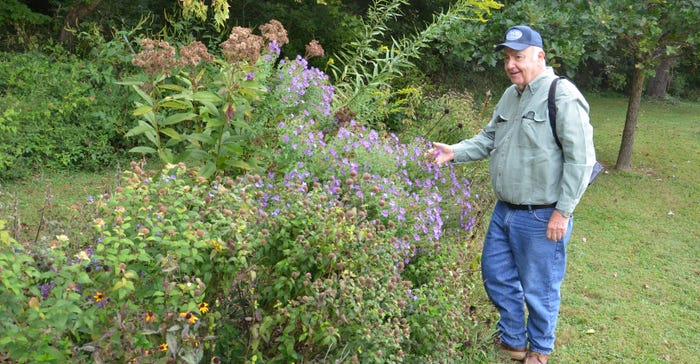
Mike Coons will be looking for bright-colored blooms on more than 40 acres of rolling land on the back side of his Indiana farm this spring. If all goes as planned and different species bloom over summer, he should see a variety of flowers this year. A wide variety of pollinators will be busy taking advantage of this habitat.
“We have several farmers interested in establishing pollinator plants on CRP acres and on other acres which aren’t as productive,” says Andy Ertel, Jennings County Soil and Water Conservation District. “Mike planted his fields in 2016, so he’s still in the establishment phase.”
The seeding on Coons’ farm in June 2016 included warm-season grasses and a variety of forbs, seeded with a no-till drill. Jenny Vogel, district conservationist with the Natural Resources Conservation Service, based in North Vernon, Ind., says they typically include at least nine species of forbs in seed mixes, and sometimes more for farm fields. Forbs are basically various species of wildflowers.
“We try to include three species which bloom relatively early, three which bloom in the summer and three which tend to bloom late,” she says. “That gives us a better chance to have blooms over the entire growing season. While there are blooms, the field attracts bees and other pollinators.”
Pollinator opportunities
Rick McFall established pollinator plants on 29 acres of Conservation Reserve Program land in 2014. He no-tilled forbs into the field using the Jennings County SWCD no-till drill. It’s equipped with an attachment for seeding grasses and forbs.
Right now, national CRP acres have bumped against the cap set by Congress, Vogel says. “You can talk to your local office and be ready to apply if signup is opened, but no contracts are being granted right now,” she says.
Both Coons and McFall signed up for CRP SAFE, which stands for State Acres for Wildlife Enhancement. They also signed up for a program funded by a Clean Water Indiana grant that provided $200 per acre for establishment of this habitat. The primary goal for SAFE is establishing habitat for the Henslow sparrow or bobwhite quail. In Jennings County, the program develops habitat primarily for the Henslow sparrow, Vogel says.
Coons took advantage of a special incentive program for planting pollinator plants available through the Jennings SWCD. “We received a Clean Water Indiana grant so we could offer incentives for people to plant pollinators,” Ertel explains. That money has been exhausted.
There is still opportunity to enroll in the Environmental Quality Incentives Program through NRCS and plant pollinator plants as a practice, Vogel says. Enrollment for that program is continuous.
After seeding, the first two to three years are considered the establishment phase, Ertel says. If weeds become an issue, mowing is a possible remedy. You can mow anytime up until the third year, unless NRCS does a status review and notes that species are established. Make sure to notify the local Farm Service Agency office before mowing, Ertel cautions.
Plans also call for midcontract management starting in year four, Vogel says. “You can do a prescribed burn if you follow the proper procedures, or you can do strip disking. You disk strips on a third of the field the first year, and rotate strips until the entire cover has been treated. You can also interseed forbs back into the field.
“The idea is to make sure forbs can compete once warm-season grasses become well-established,” Vogel explains. “Forbs come back very well after burning or disking.”
More plots
Thanks to the SWCD’s “Share Some Space” initiative, pollinator plots are popping up all over the county, not just on farms, Ertel says. For example, a city park planted a quarter acre by a walking trail. Three acres were planted at the Southeast Purdue Agricultural Center, 5 acres at Eco Lake Park and 4 acres at the Calli Nature Preserve.
“People have definitely been walking the talk,” Ertel adds. The SWCD chairman planted 3 acres at his home. A city attorney also planted 3 acres on his property, and both the circuit court and superior court judges planted pollinator plants on their properties.
More than 10 acres will be established soon at Sand Creek Elementary School. Six elementary schools and the Jennings County FFA planted monarch butterfly gardens to study the species.
“The monarch butterfly must have milkweed to complete its life cycle,” Ertel says. “With milkweed disappearing due to better weed control, it’s threatened the monarch species.”
To see some examples of these pollinator plantings, click through the slideshow below.
About the Author(s)
You May Also Like




